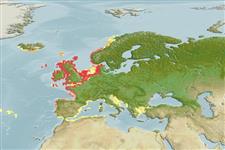Common names from other countries
Environment: milieu / climate zone / depth range / distribution range
বাস্তুসংস্থান
; ঈষৎ লোনা ; গভীরতার পরিসীমা 5 - 40 m (Ref. 85345). Temperate
Atlantic and the Mediterranean Sea: Europe & Northern Asia (excluding China). Temperate and subtropical.
Length at first maturity / আকৃতি / ওজন / Age
Maturity: Lm ? range ? - ? cm
Inhabit estuarine and inshore areas, in mud or substrates of silt to fine sand. A microvore that feeds on organic detritus as well as a carnivore-scavenger (Ref. 96352). Free-living (Ref. 3123).
Life cycle and mating behavior
পরিপক্কতা | প্রজনন | ডিম ছাড়া | ডিমসমূহ | ডিম্বধারন ক্ষমতা | শুককীট
Members of the class Ophiuroidea are mostly gonochoric, others are protandric. Fertilization is external. Brooding is common, bursae is used as brood chambers where the embryos develop into juveniles and later crawl out from the bursal slits. Life cycle: Embryos hatch into free-swimming planktotrophic larvae and later metamorphose into tiny brittle stars which sink down the bottom where they grow into adult form.
Garmendia, J.M., J.M. Parada and J. Mora. 2003. (Ref. 2795)
IUCN Red List Status (Ref. 130435)
CITES status (Ref. 108899)
Not Evaluated
Not Evaluated
Human uses
| FishSource |
হাতিয়ার
আরো তথ্য
Age/Size
বৃদ্ধি
Length-weight
Length-length
বহিঃ অঙ্গ সংস্থান
শুককীট
প্রাচুর্য
ইন্টারনেট সুত্র
Estimates based on models
Preferred temperature
(Ref.
115969): 8.4 - 12.4, mean 10.3 (based on 164 cells).
Price category
Unknown.
